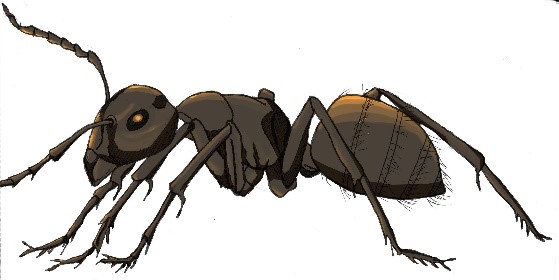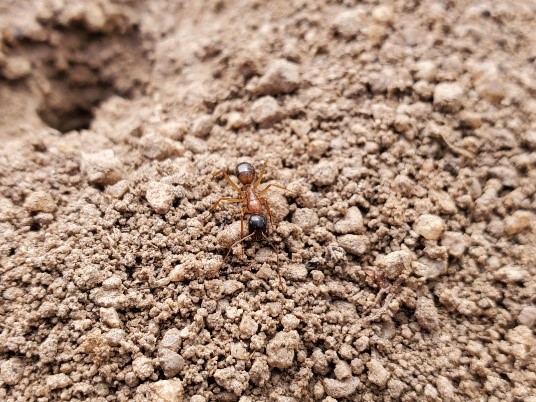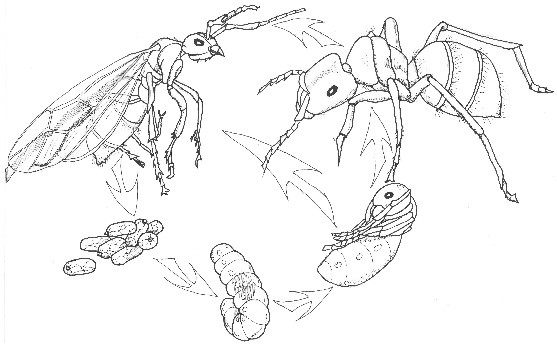Common name: Carpenter ant
Scientific name: Camponotus spp.
Description:
Carpenter ants are some of the largest ants found in the United States; they can range from ¼ inch to ½ inch in size and come in a variety of colors. The best way to identify a carpenter ant is to look for a single node at their thin waist, hairs around their anal opening, and an evenly round thorax (these can be seen in the photo below).
 Carpenter ant illustration. Illustration by James Schwarz.
Carpenter ant illustration. Illustration by James Schwarz.
Behavior:
Carpenter ants are most active at dusk. Unlike pavement ants, carpenter ants do not create mounds of dirt and instead can leave sawdust piles. They are capable of traveling over 100 yards to search for foods and to establish satellite nests. Satellite nests are offshoots of the “parent” nest. This occurs when the colony as a whole becomes larger and some of the worker and brood ants set up an additional nest in order to have more space or be closer to a food source. It is uncommon for the “parent” nest to be inside a home or structure, but it is very common for a satellite nest and it can cause damage to structural wood and wood siding that has water damage. Identifying whether there are multiple nests and finding the original one is key to carpenter ant management.
 Adult Carpenter Ant. Photo by Wendy Hanson Mazet.
Adult Carpenter Ant. Photo by Wendy Hanson Mazet.
Life cycle:
A carpenter ant colony includes one queen and several thousand worker ants. The queen is the only female ant in the colony to reproduce. Ants have four major life stages: egg, larva, pupa and adult. The average worker ant can live for four to five years, with the queen capable of living as long as 15 years. Each spring, homeowners may see swarms of flying carpenter ants. These swarms are reproductive adults that are mating. While male flying ants die after mating, female flying ants lose their wings and then establish a new colony.
 Ant lifecycle illustrated. Illustration by James Schwarz.
Ant lifecycle illustrated. Illustration by James Schwarz.
Diet and damage:
Carpenter ants eat a variety of foods, including other insects, nectar and sugary foods. It is important to monitor for carpenter ants, as they are capable of damaging compromised wood in buildings. Unlike termites, ants do not consume the wood; they only chew it to make space for their nest. In nature, this tunneling is beneficial to decaying trees; however, it can be dangerous when they find a spot inside our homes. Carpenter ants do not sting, but rarely they may bite humans, causing a stinging sensation.
Monitoring:
It is important to observe the ant colony before doing any control methods, as their behavior can tell you some helpful information. By watching their trails, particularly at dusk, you may be able to identify one or more nests, as well as finding damaged areas. Nests can be found both within the home and outside. If you are unable to find trails, nontoxic baits can be set out to create trails for you to observe. Help with identification is available by contacting your local Extension office.
Cultural/Mechanical control:
Pruning tree branches that are near or touching the home can help reduce entrances for the ants. Using caulk to seal any holes or cracks in the house can also be beneficial. Firewood should be stored off the ground and not against structures. Removing any wood in the home that is damaged will also help reduce populations or prevent them from establishing.
Chemical control:
There are several synthetic and organic insecticides available to control ants, but applying them without being able to target the nests is ineffective. Organic products such as diatomaceous earth may reduce populations. If the nest is unreachable, holes should be drilled into the wood by a pest management professional to gain access to the nest. Baits are another control method used for ants, however it takes time for the baits to work. Make sure that ants are listed as one of the target pest of the baits before purchasing. Bait attractiveness can depend on the time of year and the ant’s choice in food source at that time. When applying a pesticide, read the entire product label thoroughly before application.


